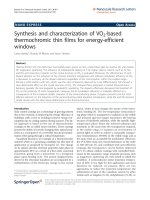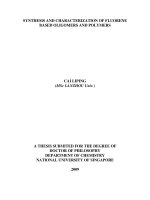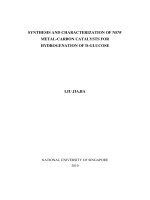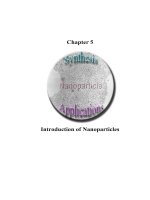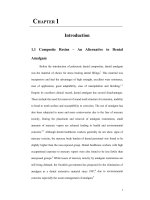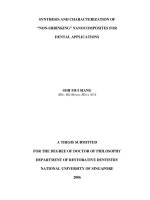Synthesis and characterization of polyaniline based materials: Their biological relevance - An overview
Bạn đang xem bản rút gọn của tài liệu. Xem và tải ngay bản đầy đủ của tài liệu tại đây (688.87 KB, 13 trang )
Int.J.Curr.Microbiol.App.Sci (2017) 6(5): 2309-2321
International Journal of Current Microbiology and Applied Sciences
ISSN: 2319-7706 Volume 6 Number 5 (2017) pp. 2309-2321
Journal homepage:
Original Research Article
/>
Synthesis and Characterization of Polyaniline Based materials:
Their biological relevance- An Overview
Sunandana Mandal*, Swadhin Kumar Saha and Pranesh Chowdhury
Department of Chemistry, Siksha-Bhavana, Visva-Bharati, Santiniketan-731235, India
*Corresponding author
ABSTRACT
Keywords
Polyaniline based
materials,
Synthesis,
Characterization,
biological relevance
Article Info
Accepted:
30 April 2017
Available Online:
10 May 2017
The present paper reveals the synthesis of polyaniline, polyaniline nanoparticles and
polyaniline composite. Improvement of polyaniline properties can be achieved either
by forming composites and nanocomposites of aniline, or blends with commercially
available polymers or inorganic materials which offer better mechanical and optical
properties, stability and process ability. Thus nanostructured (nanoparticles/-rods/wires) conducting polyaniline offer great research interests. The synthesis of
Polyaniline nanoparticles have been studied by sonochemical techniques. The
synthesized nanoparticles were characterized by TEM images. The PANI/PVA/Ag
nanocomposites were synthesized by chemical oxidation polymerization of aniline
monomer in the presence of PVA and Ag nanoparticle colloidal solution. The
antibacterial activity of the obtained nanocomposite was evaluated against Gram
positive bacteria Staphylococcus aureus (S. aureus) and gram negative bacteria
Escherichia coli (E. Coli) using paper disc diffusion method. The antibacterial study
showed that the PANI/PVA composite did not have a very good antibacterial activity
but PANI/PVA/Ag composites were found to be effective against two bacteria.
Introduction
With the discovery in 1960 of intrinsically
conducting polymers (ICPs), an attractive
subject of research was initiated because of
the interesting properties and numerous
application possibilities of ICPs. Conductive
polymers have various applications such as
rechargeable batteries (1), electromagnetic
interferences (EMI) shielding (2), antistatic
coatings3, gas sensors4, optical devices5,
removal of heavy metal from water and waste
water (6-7), etc. However, many of the
potential uses for ICPs have yet to be
explored because of a number of obstacles
that need to be overcome. Among the
available ICPs, polyaniline (PANI or PAn) is
found to be the most promising because of its
ease of synthesis, environmental stability, low
cost monomer, tunable properties, better
stability compared to other ICPs, good redox
reversibility and stability in aqueous solutions
and air for its applications 8-9 in
electrochromic
displays
(10),
electrocatalysis11, rechargeable batteries (1214), and sensors (15). The thermal stability of
PANI is superior to other ICPs. The
processability is also fairly good. All these
factors contribute to PANI being superior to
other ICPs. It also has a wide range of
electrical properties which can be easily
controlled by changing its oxidation and
protonation sites (16-17).
2309
Int.J.Curr.Microbiol.App.Sci (2017) 6(5): 2309-2321
The main problem associated with the
effective utilization of all ICPs including
PANI is inherent in their lower level of
conductivity compared to metal, and their
infusibility and poor solubility in all available
solvents 18-19.There is ample scope for
modifying the conductivity and processability
of PANI through the selection of a suitable
dopant and suitable level of doping and also
by controlling its structure during synthesis
(20-21). Another avenue for the successful
utilization of PANI is through blending it with
a commercially available polymer that has
good
processability
and
mechanical
properties.
ICPs are inherently conducting in nature due
to the presence of a conjugated electron
system in their structure. A high level of
conductivity (near metallic) can be achieved
in ICPs through oxidation–reduction as well
as doping with a suitable dopant 22=23. The
first ICP to be discovered was polyacetylene,
synthesized by Shirakawa Louis et al., 24.
Following the study on polyacetylene, other
polymers such as polypyrrole (PPY),
polythiophene,
PANI,
poly(pphenylenevinylene), and poly(p-phenylene),
as well as their derivatives, have been
synthesized and reported as a new group of
polymers known as ICPs. The conductivity of
doped polyacetylene is comparable with that
of metallic copper but its stability and
processability are very poor compared to
normal polymer (Fig. 2) even with respect to
those shown in Fig. 1. The conductivity of
polypyrrole, polythiophene and PANI is
comparatively less but these polymers have
better stability and processability compared to
those of polyacetylene and polyphenylene.
The main polyaniline structure is in Fig.3, in
which n+m =1, x= half degree of
polymerization.
Polyaniline can be found in one of the three
following idealized oxidation states (25),
which are polymerized from the inexpensive
aniline monomer (Fig.4):
Leucoemeraldine – white/clear & colorless
(C6H4NH) n with n = 1, m = 0 is the fully
reduced state.
Pernigraniline– blue/violet (C6H4N)n is the
fully oxidized state (n = 0, m = 1) with imine
links instead of amine links. Studies have
shown that most forms of polyaniline are one
of the three states or physical mixtures of
these components.
Emeraldine– green for the emeraldine salt,
blue for the emeraldine base ([C6H4NH]
2[C6H4N] 2) n with (n = m = 0.5) often
referred to as emeraldine base (EB), is
neutral; if doped (protonated) it is called
emeraldine salt (ES), with the imine nitrogens
protonated by an acid.
Emeraldine base is regarded as the most
useful form of polyaniline due to its high
stability at room temperature and the fact that,
upon doping with acid, the resulting
emeraldine salt form of polyaniline is highly
electrically conducting26. Leucoemeraldine
and pernigraniline are poor conductors, even
when doped with an acid.
The colour change associated with polyaniline
in different oxidation states (Fig.5) can be
used in sensors and electrochromic devices27.
Although colour is useful, the best method for
making a polyaniline sensor is arguably to
take advantage of the dramatic changes in
electrical conductivity between the different
oxidation states or doping levels28. Treatment
of emeraldine with acids increases the
electrical conductivity by ten orders of
magnitude. Undoped polyaniline has a
conductivity of 6.28×10−9 S/m, while
conductivities of 4.60×10−5 S/m can be
achieved by doping to 4% HBr29. The same
2310
Int.J.Curr.Microbiol.App.Sci (2017) 6(5): 2309-2321
material can be prepared by oxidation of
leucoemeraldine.
Polyaniline is more noble than copper and
slightly less noble than silver which is the
basis for its broad use in printed circuit board
manufacturing (as a final finish) and in
corrosion protection (30).
Improvement of polyaniline properties can be
achieved either by forming composites and
nanocomposites of aniline, or blends with
commercially available polymers or inorganic
materials which offer better mechanical and
optical properties, stability and processability
(31-34). Thus nanostructured (nanoparticles/rods/-wires) conducting polyaniline with
unusual physical and chemical properties
have attracted great research interests. Much
research has been conducted on the
nanostructure of polyaniline (PANI) because
it exhibits enhanced performance in
applications where a high surface contact area
is needed between the nanostructures and its
environment. Recently various strategies
including sonochemical synthesis, template
synthesis, interfacial polymerization, selfassembly and stepwise electrochemical
deposition have been developed for the
preparation of polyaniline nanostructures (3539). Although various methods of preparing
PANI nanostructures have been reported, new
simple and economic methods are still being
explored.
The main objectives of the present study
reflects
Synthesis and characterization of Polyaniline
based materials
Study of their chemical and electrochemical
properties
Searching for biological relevance
Fig.1 The structure of a number of intrinsically conducting polymers (ICP)
2311
Int.J.Curr.Microbiol.App.Sci (2017) 6(5): 2309-2321
Fig.2 The conductivity of a number of ICPs relative to copper and liquid mercury
Fig.3 Main polyaniline structure
Fig.4 Three forms of PANI
2312
Int.J.Curr.Microbiol.App.Sci (2017) 6(5): 2309-2321
Fig.5 Colour change associated with polyaniline in different oxidation states
Fig.6 Sketch of Emeraldine Base (EB) before Protonation (a); after 50% protonation (b);
Formation of Bipolaron (c); and Polaron (d)
Fig.7.Poralons and Bipolarons vin PANI structures
2313
Int.J.Curr.Microbiol.App.Sci (2017) 6(5): 2309-2321
Fig.8 Shimadzu UV-VIS Spetrophotometer
Fig.9 Sonicator (Branson 1510)
Fig.10 High resolution Transmission Electron
Microscope (HRTEM) (JEM-2100, 200kv, jeol)
Fig.11 Centrifuge Machine
Aniline hydrochloride and Ammonium Persulfate reacts to form Emeraldine
2314
Int.J.Curr.Microbiol.App.Sci (2017) 6(5): 2309-2321
Fig.12 Sound frequency ranges
0
10
10 103 104 105
106 107
Human hearing 16Hz-18kHz
Conventional power ultrasound 20kHz-40kHz
Range for sonochemistry 20kHz-2MHz
Diagnostic ultrasound 5MHz-10MHz
Fig.13 Process of Synthesizing PVA/PANI/Ag nanocomposite from AgNP, PVA and PANI
Fig.14 TEM images of the sonochemical synthesized PANI nanofibers with APS/Aniline molar
ratios of (a) 0.5, (b) 1.0, (c) 1.5 and (d) 2.0. (Reproduced with permission from Jing et al., [44])
2315
Int.J.Curr.Microbiol.App.Sci (2017) 6(5): 2309-2321
Fig.15. Antibacterial activity of various nanocomposites against two pathogenic strains; E. coli
and Staph. aureus shown by the paper disk diffusion method; 5%
(A); 10% (B); 15% (C); 20% (D); 25% (E)
Fig.16 Scatter plot of inhibition zone versus various PVA/PANI/Ag nanocomposites at different
concentrations of Ag nanopaticles: 5% (A); 10% (B); 15% (C); 20% (D); 25 % (E)
Table.1 Average inhibition zones obtained from various nanocomposites at different
concentrations of silver nanoparticles; 5% (A); 10% (B); 15% (C); 20% (D);
25% (E); 0% (F) against two pathogenic bacteria
Samples
A
B
C
D
E
F
Average of formed inhibition zone (mm)
E. coli
S. aureus
7
10
8
12
12
15
9
9
8
8
0
0
Instruments
Synthesis of Polyaniline
The UV-Vis spectrum was recorded by
Shimadzu UV-vis spectrophotometer. A
sonicator (Branson-1510) was used to obtain
ultrasound of 40 kHz. Centrifuge machine
(REMI) was used for centrifugation. Particle
size and its distribution were recorded using
Transmission Electron Microscope (TEM)
(JEM-2100, 200kv, Jeol).
Although the synthetic methods to produce
polyaniline are quite simple, the mechanism
of polymerization is probably complex.
A. The formation of leucoemeraldine can be
described as follows, where [O] is a generic
oxidant (40):
2316
Int.J.Curr.Microbiol.App.Sci (2017) 6(5): 2309-2321
n C6H5NH2 + [O] → [C6H4NH]n + H2O
medical imaging.
The most common oxidant is ammonium
persulfate. The components are each
dissolved in 1 M hydrochloric acid (other
acids can be used), and the two solutions
slowly combined. The reaction is very
exothermic. The polymer precipitates as an
unstable dispersion with micrometer-scale
particulates.
For the synthesis of nanostructured PANI
sonochemical process is initiated with the
drop-wise addition of an acidic APS
(Ammonium persulfate) solution to an acidic
aniline solution, similar to that of
conventional PANI synthesis. However, the
polymerization is accomplished with the aid
of ultrasonic irradiation. Jing et al.,
synthesized PANI nanofibers with high
polymer yields using this technique 42-43. If
the concentration of aniline and APS is high,
three possible competitive reactions may be
operative within the system: (i) the
continuous formation of primary PANI
nanofibers; (ii) the conversion of the primary
nanofibers into thicker fibers with uneven
surfaces; and (iii) the growth and
agglomeration of the thicker fibers into
irregular particles. In the conventional method
of preparation, irregular PANI particles are
obtained because of the simultaneous
occurrence of reactions (ii) and (iii). While
during the sonochemical synthesis, the further
growth and agglomeration of the primary
nanofibers are effectively prevented (even if
more aniline and APS were added into the
system), following the formation of more
primary PANI nanofibers (42). One of the
advantages of this approach is its scalability
in comparison with other approaches such as
interfacial polymerization or rapid mixing
reaction.
B. (Per) nigraniline is prepared by oxidation
of the emeraldine base, one typical oxidant
being meta-chloroperoxybenzoic acid (41):
{[C6H4NH]2[C6H4N]2}n + RCO3H →
[C6H4N]n + H2O + RCO2H
C. Anniline hydrochloride and Ammonium
Persulfate reacts to form Emaraldine (Fig.
12).
Synthesis of polyaniline Nanoparticles
(Using sonochemical techniques)
High-power
ultrasound
can
generate
cavitation within a liquid and through
cavitation provide a source of energy which
can be used to enhance a wide range of
chemical processes. Such uses of ultrasound
have been grouped under the general name
sonochemistry. Ultrasound is defined as
sound of a frequency beyond that to which the
human ear can respond. The normal range of
hearing is between 16 Hz and about 18 kHz
and ultrasound is generally considered to lie
between 20 kHz to beyond 100 MHz.
Sonochemistry generally uses frequencies
between 20 and 40 kHz. However since
cavitation can be generated well above these
frequencies,
recent
researches
into
sonochemistry use a much broader range (Fig.
12). High frequency ultrasound from around 5
MHz and above does not produce cavitation
and this is the frequency range used in
Synthesis of Polyaniline Composite
With exposure to Ag nanoparticles on
PANI/PVA composite, a new nanocomposite
was
obtained.
The
PANI/PVA/Ag
nanocomposites
were
synthesized
by
chemical oxidation polymerization of aniline
monomer in the presence of PVA and Ag
nanoparticle colloidal solution. In a typical
synthesis process aniline hydrochloride was
added to the prepared Ag nanoparticles
2317
Int.J.Curr.Microbiol.App.Sci (2017) 6(5): 2309-2321
colloidal solution (200ml). The obtained
mixture was stirred for 10 min and then the
PVA aqueous solution (which dissolve with
0.1M HCl) was added and the mixture was
stirred for 30 min. By addition of the aquous
solution of ammonium persulfate, the mixture
was allowed to react for 12h under constant
stirring at -30C.
Metal nanoparticles are generally obtained
from noble metals like silver, gold, platinum,
titanium, copper and tin.Silver Nanoparticle
colloidal solution was synthesized using
NaBH4 as a reducing agent. The chemical
reduction of Ag+ ions to Ag nanoparticles by
NaBH4 is as follows:
AgNO3 + NaBH4 Ag + ½ B2H6 + ½ H2 +
NaNO3
The most possible approach to stabilise
nanoparticles, especially Ag nanoparticles,
and preparation of nanocomposites, is using
polymers to improve polymer properties is to
combine the desired polymer with other
polymers which have better properties.
PANI has many advanteges but has low
solubility in several common solvents. IN
fact, PVA improved the solubility of PANI
and this novel composite can be applied for
Ag nanopaticle coating.
The process of synthesizing PVA/PANI/Ag
nanoparticles is shown in fig 13.
Characterization of synthesised Polyaniline
Nanoparticles
The TEM images of PANI nanofibers
synthesized by the sonochemical method at
different APS to aniline molar ratios are
presented in Fig. 14. The diameter of the
sonochemical synthesized PANI nanofibers
with different APS to aniline ratios is ~50 nm.
However, the length of the nanofibers
decreases with the increase in the APS to
aniline ratio44.
Biological
property
Relevance:
Antibacterial
The antibacterial activity of the obtained
nanocomposite was evaluated against Gram
positive bacteria Staphylococcus aureus
(Staph. aureus) and gram negative bacteria
Escherichia coli (E. coli) using paper disc
diffusion method. The antibacterial study
showed that the PANI/PVA composite did not
have a very good antibacterial activity but
PANI/PVA/Ag composites were found to be
effective against two bacteria. PVA/PANI/Ag
nanocomposites were tested for antibacterial
activity using E.coli and Staph. aureus. Fig.
15 shows the inhibition zones that were
formed by nanocomposite samples. The
diameter of the inhibition zones are 7, 8, 12, 9
and 8 mm and 10, 12, 15, 9, and 8 mm against
E. coli and Staph. aureus respectively. The
results are summarized and presented in Table
1. It is observed that PVA/PANI composite
(sample of F) which was used as a control
matrix, exhibited no antibacterial activity
when
compared
with
PVA/PANI/Ag
nanocomposites. The scatter plot of the
inhibition zone versus various PVA/PANI/Ag
nanocomposites is presented in Fig. 16.
According to Fig. 16 the PVA/PANI/Ag
nanocomposite (C) with 15% Ag nanoparticle
showed better antibacterial activity against E.
coli and Staph. aureus. Silver exhibits
outstanding antibacterial property that would
lead to biomedical applications. The
antibacterial activity of silver is dependent on
Ag+ that binds strongly to electron donor
groups on biological molecules like sulfur,
oxygen or nitrogen. The silver ions act by
displacing other essential metal ions such as
Ca2+ or Zn2+. At low concentrations of
nanoparticles, the interaction of particles with
the cell wall of bacteria decreases and at the
2318
Int.J.Curr.Microbiol.App.Sci (2017) 6(5): 2309-2321
high concentrations of the particles, the
aggregation probability of particles increases,
as a result, the effective surface to volume
ratio of particles and so the resulting
interaction between particles and the cell wall
of bacteria decrease.
9.
10.
References
1.
2.
3.
4.
5.
6.
7.
8.
Epstein, A.J. and A.G. MacDiarmid,
1995. Polyanilines: From solitons to
polymer metal, from chemical currosity
to technology. Synth. Met., 69(1-3):
179-182.
Ohtani, A., M. Abe, M. Ezoe, T. Doi, T.
Miyata and A. Miyke, 1993. Synthesis
and properties of high-molecular-weight
soluble polyaniline and its application
to the 4MB-capacity barium ferrite
floppy disk's antistatic coating. Synth.
Met., 57(11): 3696-3701.
Matsuguchi, M., J. Io, G. Sugiyama and
Y. Sakai, 2002. Effect of NH3 gas on
the electrical conductivity of polyaniline
blend films. Synth. Met., 128(1): 15-19.
Falco, E.H. and W.M. De Azevedo,
2002. Polyaniline-polyvinyl alcohol
composite as an optical recording
material, Synth. Met., 128(2): 149-154.
Eisazadeh, H., 2007. Removal of
Chromium from waste water using
polyaniline. J. Appl. Polym. Scie,
104(1): 1964-1967.
Eisazadeh, H., 2008. Removal of
Arsenic in water using Polypyrrole and
its Composites, W. Appl. Sci. J., 3(1):
10-13.
Eisazadeh, H., 2007. Removal of
Mercury from water using Polypyrrole
and its Composites, Chin, J, Polym.
Scie, 25(4): 393-397.
Mirmohseni A, Solhjo. Preparation and
characterization of aqueous polyaniline
battery using a modified polaniline
electrode. Eur. Polym, J. 2003;
39(2):219-23.
11.
12.
13.
14.
15.
16.
17.
2319
Moraes SR, Huerta-Vilca D, Motheo
AJ. Characteristics of polyaniline
synthesized in phosphate buffer
solution. Eur. Polym J 2004; 40(9):
2033-41.
Kobayashi T, Yoneyama H. Tamura H.
Electrochemical reactions concerned
with electrochromism of polyaniline
film-coated electrodes. Electroanal
Chem 1984; 177 (1-2): 281-91.
Carlin CM, Kepley LJ, Bard AJ,
Polymer films on electrodes, XVI, In
situ ellipsometric measurements of
polybiopyrazine, polyaniline, and poly
(vinylferrocene) films. J Electrochem
Soc 1985; 132(2): 353-9.
MacDiarmid AG, Mu SL, Somasiri
NLD,
Wu
W.
Electrochemical
characteristics of polyaniline cathodes
and anodes in aqueous electrolytes. Mol
Cryst Liq Cryst 1985; 121 (1-4): 18790.
Mu SL, Ye JH, Wang YH, A
rechargeable
Zn/ZnCl2,
NH4Cl/polyaniline/carbon dry battery, J
Power Sources 1993; 45(2): 153-9.
Oyama N, Tatsuma T, Sato T, Sotomura
T. Dimercaptan-polyaniline composite
electrodes for lithium batteries with
high energy density. Nature 1995;
373(6515): 598-9.
Kan JQ, Pan XH, Chen C. Polyanilineuricase biosensor prepared with
template process. Biosens Bioelectron
2004; 19(2): 1635-40.
Huang, W.S., B.D. Humphrey and A.G.
MacDiarmid, 1986. Polyaniline, a novel
conducting polymer, Morphology and
chemistry of its oxidation and reduction
in aqueous electrolytes. J. Chem. Soc.,
82(1): 2385-2400.
Chiang, J.C. and A.G. MacDiarmid,
1986. Polyaniline: Protonic Acid
Doping of the Emeraldine Form to the
Metallic Regime. Synth. Met., 13(1):
193-198.
Int.J.Curr.Microbiol.App.Sci (2017) 6(5): 2309-2321
18.
19.
20.
21.
22.
23.
24.
25.
26.
Cho MS, Park SY, Hwng JY, Choi HJ.
Synthesis and electrical proper-ties of
polymer composites with polyaniline
nanoparticles. Mater Sci Eng C 2004;
24:15–8.
Rao
PS,
Subrahmanya
S,
Sathyanarayana DN. Synthesis by
inverse
emulsion
pathway
and
characterization
of
conductive
polyaniline–poly
(ethylene-co-vinyl
acetate) blends. Synth Met 2003;
139:397–404.
Bhadra S, Chattopadhyay S, Singha
NK, Khastgir D. Improvement of
conductivity
of
electrochemically
synthesized polyaniline. J Appl Polym
Sci 2008; 108:57–64.
Bhadra S, Singha NK, Khastgir D.
Polyaniline by new miniemulsion
polymerization and the effect of
reducing agent on conductivity. Synth
Met 2006; 156:1148–54.
Wise DL, Wnek GE, Trantolo DJ,
Cooper TM, Gresser JD. Electrical and
optical polymer systems. New York:
Marcel Dekker; 1997. p. 23.
Unsworth J, Lunn BA, Innis PC, Jin Z,
Kaynak A, Booth NG. Tech-nical
review: conducting polymer electronics.
J Intel Mat Syst Str 1992; 3:380–95.
Shirakawa Louis HEJ, MacDiarmid
AG, Chiang CK, Heeger AJ. Synthe-sis
of electrically conducting organic
polymers: halogen derivatives of
polyacetylene, (CH) x. J Chem Soc
Chem Commun 1977:578–80.
Feast, W.J.; Tsibouklis, J.; Pouwer,
K.L.; Groenendaal, L.; Meijer, E.W.
(1996). "Synthesis, processing and
material properties of conjugated
polymers". Polymer 37 (22): 5017. Doi:
10.1016/0032-3861(96)00439-9.
MacDiarmid,
Alan
G.
(2001).
"Synthetic Metals": A Novel Role for
Organic Polymers (Nobel Lecture)".
Angewandte Chemie International
27.
28.
29.
30.
31.
32.
33.
34.
2320
Edition
40
(14):
2581.
Doi:
10.1002/1521-3773(20010716)
Huang, Li-Ming; Chen, Cheng-Hou;
Wen, Ten-Chin (2006). "Development
and
characterization
of
flexible
electrochromic devices based on
polyaniline
and
poly
(3,
4ethylenedioxythiophene)-poly (styrene
sulfonic acid)". Electrochimica Acta 51
(26):
5858.
doi:10.1016/j.electacta.2006.03.031.
Virji, Shabnam; Huang, Jiaxing; Kaner,
Richard B.; Weiller, Bruce H. (2004).
"Polyaniline Nanofiber Gas Sensors:
Examination
of
Response
Mechanisms". Nano Letters 4 (3): 491.
Bibcode: 2004NanoL...4...491V. Doi:
10.1021/nl035122e.
Hammo, Shamil M. (2012). "Effect of
Acidic Dopants properties on the
Electrical Conductivity of Poly aniline".
Tikrit Journal of Pure Science 17 (2).
Wessling, Bernhard (2010). "New
Insight into Organic Metal Polyaniline
Morphology and Structure". Polymers 2
(4): 786. Doi: 10.3390/polym2040786.
Paoli, M.A.D.E., R.J. Waltman, A.F.
Diaz and J. Bargon, 1984. Conductive
composite from poly (vinyl chloride)
and polypyrrole. J. Chem. Soc. Chem.
Commun., 15: 1015-1016.
Lindsey, S.E. and G.B. Street, 1984/85.
Conductive composites from poly (vinyl
alcohol) and polypyrrole. Synth. Met.,
10(1): 67-69.
Cassignol, C., M. Cavarero, A. Boudet
and A. Ricard, 1999. Microstructureconductivity relationship in conducting
polypyrrole/epoxy
composites.
Polymer, 40(5): 1139-1143.
Bhat, N.V., A.P. Gadre and V.A.
Bambole, 2001. Structural, mechanical
and
electrical
properties
of
electropolymerized
polypyrrole
composite films, J. Appl. Polym. Sci.,
80(13): 2511-2516.
Int.J.Curr.Microbiol.App.Sci (2017) 6(5): 2309-2321
35.
36.
37.
38.
39.
40.
Huang, J., Virji S, Weiller BH, Kaner
RB, 2004. Nanostructured polyaniline
sensors. Chem. Eur. J., 10(6): 13141319.
Huang, J. and R. B. Kaner, 2004.
Nanofiber formation in the chemical
polymerization
of
aniline:
A
mechanistic study. Angew Chem., Int.
Ed., 43(43): 5817-5821.
Dong, H., S. Prasad, V. Nyame and W.
Jone, 2004. Sub-mcrometer conducting
polyaniline tubes prepared from
polymer fiber templates. Chem Mater,
16(3): 371-373.
Ma, Y., J. Zhang, G. Zhang and H. He,
2004. Polyaniline nanowires on Si
surfaces
fabricated
with
DNA
templates. J. Am. Chem. Soc., 126(22):
7097-7101.
Huang, J. and R. Kaner, 2004. A
general chemical route to polyaniline
nano W bers. J. Am. Chem. Soc.,
126(3): 851-855.
Chiang, J.C.; MacDiarmid, A. G.
(1986). "'Polyaniline': Protonic Acid
41.
42.
43.
44.
Doping of the Emeraldine Form to the
Metallic Regime". Synthetic Metals 1
(13):
193.
Doi:
10.1016/03796779(86)90070-6.
Sapurina, I. Yu. and Shishov, M. A.
(2012) "Oxidative Polymerization of
Aniline: Molecular Synthesis of
Polyaniline and the Formation of
Supramolecular Structures", in New
Polymers for Special Applications,
Ailton De Souza Gomes (Ed.), ISBN
978-953-51-0744-6,
InTech,
doi:10.5772/48758.
Jing XL, Wang YY, Wu D, She L, Guo
Y. Polyaniline nanofibers prepared with
ultrasonic irradiation. J Polym Sci
Polym Chem 2006; 44:1014–9.
S.G. Oh, D.O. Shah, J.Am. Oil
Chemists Soc. 70 (1993) 673.
Jing X, Wang YY, Wu D, Qiang JP.
Sonochemical synthesis of polyaniline
nanofibres. Ultrason Sonochem 2007;
14:75-80.
How to cite this article:
Sunandana Mandal, Swadhin Kumar Saha and Pranesh Chowdhury. 2017. Synthesis and
characterization of polyaniline Based materials: their biological relevance-An Overview.
Int.J.Curr.Microbiol.App.Sci. 6(5): 2309-2321.
doi: />
2321
